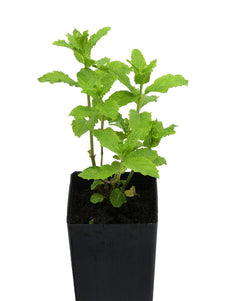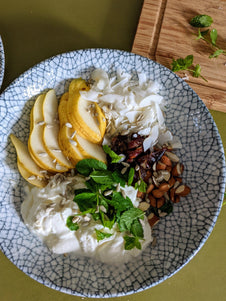







Mint - Moroccan Mint
Mint - Moroccan Mint

- In stock, ready to ship
- Inventory on the way

Usually available: All year
Life cycle: Perennial
Height: 45 - 60cm
Position: Sun / part shade
Soil preference: Moist / well drained
This is how we pack and send your Herb Plants to all states except TAS & WA
You will receive
- 1 Moroccan Mint Herb Plant in a 50 X 75mm tube - General growing instructions
All of our Herb Plants are grown organically with certified organic potting mixes and fertilizers
Botanical Name: Mentha spicata var. crispa
Moroccan Mint is a medium sized perennial, with a spreading nature, reaching a height of 45-60cm. The soft, bright green leaves are small, close set and toothed along the margins. The parent plant for this hybrid is Spearmint, so the aroma is also clearly spearmint. The flowers are lavender to lilac and appear in mid to late summer. The botanical name for Moroccan Mint is Mentha spicata var. crispa, which is also the scientific name for other varieties, with the addition of specific cultivar names, eg: Moroccan Mint.
The aroma and taste is sweet and minty, which seems obvious, but appropriate for one of the most useful culinary mints. Moroccan Mint is combined with green tea and sugar to make the drink Moroccan Tea. This beverage is popular in the Arabian nations and often takes on a ceremonial purpose, especially when the tea is made for guests by the man of the house. Moroccan Tea may also be called Tuareg or Maghrebi and Moroccan Mint is grown especially for this purpose.
Mint General
There are many Mint varieties known to herb gardeners and lovers of good cuisine, all varying slightly in flavour, aroma and appearance. They are categorized in the genus ‘Mentha’, which has up to 18 species, within the Lamiaceae family of plants. The Lamiaceae family is known as the mint family. However, the largest group of plants in the mint family is actually the delightful Salvias with their brilliantly coloured blooms. Many other commonly known herbs are also found in this family, including basil, sage, thyme and even lavender. One characteristic of this plant family is that they all yield essential oils, giving each plant its unique characteristics and even potential for medicinal use. Even the Scutellaria genus, with the unusually named Baikal Skullcap is found within this family.
The mints consist of mostly spreading and low growing perennial plants. The height range is from 10 cm to 1 meter, so not all are at ground level. Mint plants send out runners, or stolons, to help them spread by developing roots and shoots at the nodes. This allows plants to cover up to 1 meter in stem growth, in good conditions. They are all fast growing plants and due to the spreading nature, one plant is often sufficient for most gardeners. Some mints can be invasive and it is recommended that containers or in ground barriers be used. Mints can suffer from some pests like snails and aphids and may be affected by mint rust. Rust Free Mint may also be a useful addition to the garden in addition to the many other varieties.
Most mint plants have square stems, with leaves held in opposite pairs. They are often downy with a serrated margin, with a variable leaf shape and colours ranging from green to purple. The flowers are usually white to purple and present in false whorls or verticillaster or false whorl. The corolla is usually two lipped and has 4 lobes, with the upper lobe usually the largest.
Mint plants come from across the globe and will grow in most climates, including a wide range of regions across Australia. Some are annual varieties, but in cool climate zones perennial mints may best be treated as annuals and replaced each year. Generally they have high water requirements and prefer rich soils. Mint is grown commercially in Tasmania due to the ideal conditions of long summer days in high altitudes, where temperatures average 25C during the day to 15C at night. Ideal conditions usually require full sun, but part shade may be necessary as temperatures increase in warm summer regions.
Most mints have a history of traditional medicinal or herbal use for fevers, headaches and minor ailments. These plants are often used as a digestive aid in the form or herbal tea. The essential oil is also antiseptic and may be toxic in very high doses. They should be avoided by pregnant women and must not be given, or placed next to the face of babies and young children, due to the potential for breathing difficulties associated with menthol.
Mint hybridizes very easily, so there are many varieties available to suit any garden. In fact, if you have mixed plants some may hybridize in your own garden. The most popular choices are Spearmint, Peppermint and Applemint. However, many varieties in our collection, such as Ginger Mint, Eau de Cologne, Chocolate Mint and many others are also becoming well known.
Growing Conditions
Moroccan Mint is a hardy herb to have in the garden and it does well in dappled shade. It will grow in full sun, but has a preference for more shaded positions. It has medium water needs and suits a range of soil types. It is reasonably frost tolerant.
Culinary Uses
Moroccan Mint is a staple in many kitchens and fulfills many of the common mint uses due to its excellent flavour. It has a clean mint flavour and scent lending itself to many applications, particularly mint sauce. It is particularly good with cucumber, peas carrots, potato salad and yoghurt. As noted above, the beverage Moroccan Tea is prepared in combination with Moroccan Mint, green tea and sugar.
Medicinal Uses
Moroccan Mint has similar properties to Spearmint and its hybrids, so it may be used in the same manner for herbal remedies. However, other uses include use as breath freshener, a throat gargle, to ease headaches by rubbing leaves on the temple, insect repellent if rubbed on skin, and as a treatment for Irritable Bowel Syndrome and as a general digestive aid.
Other Uses
Moroccan Mint is a useful companion plant for pepper or capsicum plants and tomatoes, disguising their scent with the strong mint aroma. They may also enhance the flavour of the vegetables.
All information provided on this website is for informational purposes only. Please seek professional advice before commencing any treatment.






